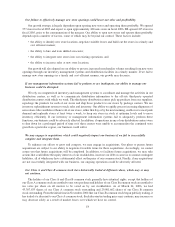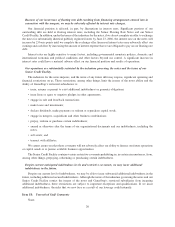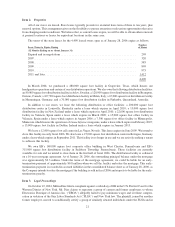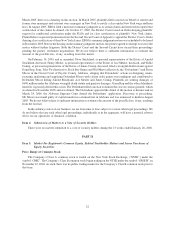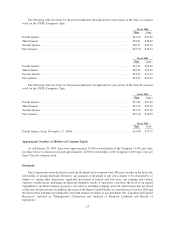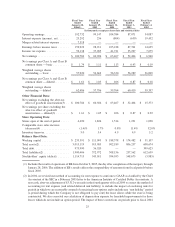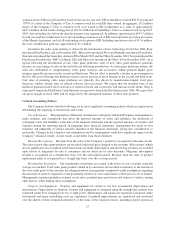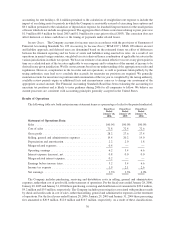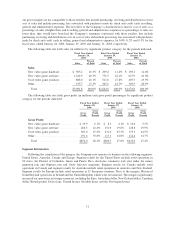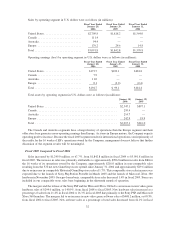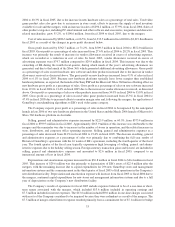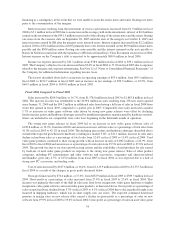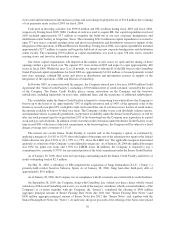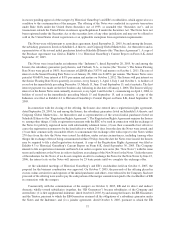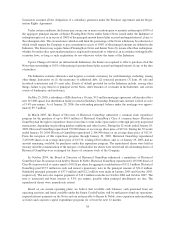GameStop 2005 Annual Report Download - page 37
Download and view the complete annual report
Please find page 37 of the 2005 GameStop annual report below. You can navigate through the pages in the report by either clicking on the pages listed below, or by using the keyword search tool below to find specific information within the annual report.which the exercise of the option is reasonably assured (generally ranging from three to ten years). Costs incurred in
purchasing management information systems are capitalized and included in property and equipment. These costs
are amortized over their estimated useful lives from the date the systems become operational. The Company
periodically reviews its property and equipment whenever events or changes in circumstances indicate that their
carrying amounts may not be recoverable or their depreciation or amortization periods should be accelerated. The
Company assesses recoverability based on several factors, including management’s intention with respect to its
stores and those stores’ projected undiscounted cash flows. An impairment loss is recognized for the amount by
which the carrying amount of the assets exceeds the present value of their projected cash flows. As a result of the
mergers and an analysis of assets to be abandoned, the Company impaired assets totaling $9.0 million. Write-downs
incurred by the Company through January 28, 2006 which were not related to the mergers have not been material.
Merger-Related Costs. In connection with the mergers, management incurred merger-related costs and
commenced integration activities which have resulted in, or will result in, involuntary employment terminations,
lease terminations, disposals of property and equipment and other costs and expenses. Approximately $65.7 million
of these costs and expenses were charged to acquisition costs, representing a portion of the recorded goodwill, and
approximately $21.1 million were charged to costs and expenses in the accompanying consolidated statement of
operations. The liability for involuntary termination benefits covers severance amounts, payroll taxes and benefit
costs for approximately 680 employees, primarily in general and administrative functions in EB’s Pennsylvania
corporate office and distribution center and Nevada call center, which are expected to be closed in the first half of
fiscal 2006. Termination of these employees began in October 2005 and is expected to be completed by July 2006.
Certain senior executives with EB received payments in the amount of $4.0 million in accordance with employment
contracts. The Pennsylvania corporate office and distribution center are owned facilities which are currently being
marketed for sale and are classified in the accompanying consolidated balance sheet as “Assets held for sale”. Sale
of these facilities is expected to occur in fiscal 2006.
The liability for lease terminations is associated with stores and the Nevada call center to be closed and will be
paid over the remaining lease terms through 2015 if the Company is unsuccessful in negotiating lease terminations
or sublease agreements. The Company began closing these stores in fiscal 2005 and intends to close the remainder
of these stores in the next 12 to 24 months. The disposals of property and equipment are related to assets of
Historical GameStop which are either impaired or have been, or will be, either abandoned or disposed of due to the
mergers. Certain costs associated with the disposition of these assets remain as an accrual until the assets are
disposed of and the costs are paid, which is expected to occur in the next few months.
Merger-related costs include professional fees, financing costs and other costs associated with the mergers and
include certain ongoing costs associated with integrating the operations of Historical GameStop and EB, including
relocation costs. The Company is working to finalize integration plans which may result in additional involuntary
employment terminations, lease and other contractual terminations and employee relocations. The Company will
finalize integration plans and related liabilities in fiscal 2006 and management anticipates completion of all
integration activities in fiscal 2006. Finalization of integration plans may result in additional liabilities which will
increase goodwill. Note 2 of “Notes to Consolidated Financial Statements” provides additional information on the
merger costs and related liabilities.
Goodwill. Goodwill, aggregating $340.0 million was recorded in the acquisition of Funco in 2000 and
through the application of “push-down” accounting in accordance with SAB 54 in connection with the acquisition
of Babbage’s in 1999 by a subsidiary of Barnes & Noble, Inc. (“Barnes & Noble”). Goodwill in the amount of
$2.9 million was recorded in connection with the acquisition of Gamesworld Group Limited in 2003. Goodwill in
the amount of $1,071.5 million was recorded in connection with the mergers. Goodwill represents the excess
purchase price over tangible net assets and identifiable intangible assets acquired. The Company evaluates goodwill
for impairment on at least an annual basis. In accordance with the requirements of Statement of Financial
Accounting Standards No. 142, Goodwill and Other Intangible Assets (“SFAS 142”), the Company completed
annual impairment tests of the goodwill attributable to its reporting unit as of the first day of the fourth quarter of
fiscal 2003 and fiscal 2004 and concluded that none of its goodwill was impaired. Through January 29, 2005, the
Company determined that it had one reporting unit based upon the similar economic characteristics of its
operations. Fair value of this reporting unit was estimated using market capitalization methodologies. Subsequent
to the mergers, the Company determined that it has four reporting units, the United States, Australia, Canada and
28


